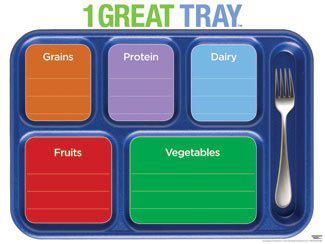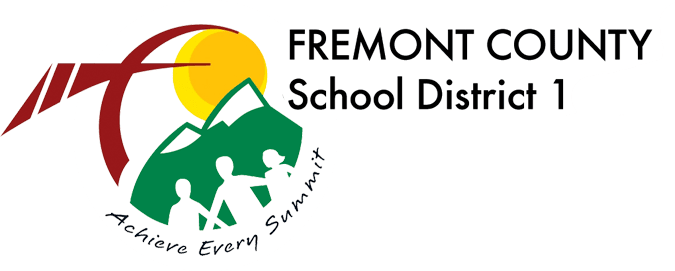Food Services
Good nutrition and academic success go hand in hand!
Our Food Services Department consists of 12 food and nutrition professionals who are dedicated to our students' health, well-being, and ability to learn. We support academic success by providing healthy meal choices—over 125,000 lunches and 33,000 breakfasts every school year—while promoting lifelong nutrition and fitness practices.
For additional questions, please contact your school's office or contact the Food Services office at (307) 332-4711.
Our Mission
Provide healthy and appealing meals for all students, in a clean and safe environment, so that every student is well nourished to gain the knowledge for success.
Meal Prices
We strongly encourage you to fill out free and reduced meal applications for the 2023–2024 school year. Applications will be available online through the parent portal or in hard copy. Hard copies can be found at your school's front office, Fremont # 1’s administration building, or online at the far left of this page. Please make sure to pay attention to the applications’ applicable dates.
| Current Prices (2023–2024) | Student Price | Adult Price |
|---|---|---|
| Elementary – Breakfast | $1.80 | $3.25 |
| Elementary – Lunch | $2.85 | $4.50 |
| LMS – Breakfast | $1.95 | |
| LMS – Lunch | $3.10 | |
| LVHS/PHS – Breakfast | $2.00 | |
| LVHS/PHS – Lunch | $3.20 | |
| Milk | $0.50 |
| Reduced Meal Prices (2023–2024) | Student Price |
|---|---|
| Breakfast | $0.30 |
| Lunch | $0.40 |
A la carte items will be offered at the high school level, but students have to have a positive balance before the purchase is allowed. Milk is provided with a complete meal at no additional charge. Extra milk or milk purchased separately will be charged to the students account.
What is a reimbursable meal?
A reimbursable meal is a federal formula which helps each district determine whether they receive a monetary reimbursement from the federal government for each meal given to students. All students are only allowed one reimbursable meal for breakfast, and one for lunch. We consider any extra items a la carte, and you must pay for them. In order to get that reimbursement, we must follow the USDA guidelines and the “Offer versus Serve” program. The lunch and breakfast programs are a little different, so let’s just start with lunch.
Lunch:
At lunch, we offer students five components with each meal. We require students to take three of those five components, including 1/2 cup of fruit and/or vegetables in order for us to count it as a “reimbursable meal”. The components offered are:

- Meat/meat alternate
- Bread/grains
- Fruit/vegetables
- Milk
There are different requirements for different age groups for certain components. For example, at the high school level, we need to offer 10 to 12 bread/grain servings each week. At the middle school we need to offer 8 to 10 bread/grain servings each week. At the elementary level, we offer 8 to 9 servings of bread/grain items each week.
Example one of a reimbursable lunch:
The main item is whole grain spaghetti with meat sauce. We put the pasta and meat sauce on the student’s tray. Because it contains a bread/grain component and the meat component, the student then only needs to take a serving of a fruit or vegetable to meet the minimum requirement for a reimbursable meal. We will not charge your student to take a carton of milk or other item offered as part of the regular lunch, such as one breadstick.
Example two of a reimbursable lunch:
The main item is chili. The chili counts as the meat/meat alternate item. Students would have to take two more components for us to count that as a reimbursable meal. They could choose from an 8 oz. carton of milk, a serving of fruit, a serving of vegetables, or a serving of a bread/grain item. Again, one of the three components on their tray has to be a serving of a fruit or vegetable.
Breakfast:
At breakfast, we must offer four food items from three required food components:
- 1–2 ounce equivalent servings of bread/grain
- ½ cup serving of fruit
- ½ cup serving of 100% juice
- Milk
Offer vs. serve at breakfast requires students to take three of the four items offered, including at least 1/2 cup of fruit and/or vegetables.
Example one of a reimbursable breakfast:
Whole grain pancakes, ½ cup fruit, and a carton of milk.
Example two of a reimbursable breakfast:
Cereal (1 oz container), one piece of toast or one package of graham crackers, one carton of milk, and ½ cup of fruit.
We train our kitchen staff to ensure that each tray holds a reimbursable meal!
Fresh Fruit and Vegetable Program
For the 2023–2024 school year, Gannett Peak Elementary and Baldwin Creek Elementary have been awarded the USDA Fresh Fruit and Vegetable Program (FFVP) grant. The FFVP provides all enrolled k–5 students with a variety of free fresh fruit and vegetables throughout the school day.
The goal of the FFVP is to:
- Create healthier school environments by providing healthier food choices.
- Expand the variety of fruits and vegetables children experience.
- Increase children’s fruit and vegetable consumption.
- Make a difference in children’s diets to impact their present and future health.
Please see the Fresh Fruit and Vegetable Program reference sheet for more details about the program.
Angel Fund
FCSD #1 Food Services maintains an Angel Fund used to support families in our community that need assistance paying for meals for their students. The Angel Fund consists of donations. The Angel Fund does not take the place of applying for free or reduced-price meals. We do not deny any student a meal, regardless of the status of the family’s account balance.
Individuals, groups, or businesses may make donations. The district Food Services Department maintains the Angel Fund, which is distributed on a case-by-case basis.
How to Donate
To make a donation, mail a check, made payable to FCSD #1 Food Services, to:
- FCSD #1 Food Service
863 Sweetwater Street
Lander, Wyoming 82520
Or drop a check off at the district office. (Be sure to write "Angel Fund" in the note section).
Questions about the School Lunch Angel Fund?
Contact Alicia McConnell at (307) 332-4711 or by email.
Food Services Staff
Alicia McConnell
Food Service Manager
Send Email
Non-Discrimination Statement
In accordance with federal civil rights law and U.S. Department of Agriculture (USDA) civil rights regulations and policies, this institution is prohibited from discriminating on the basis of race, color, national origin, sex (including gender identity and sexual orientation), disability, age, or reprisal or retaliation for prior civil rights activity.
Program information may be made available in languages other than English. Persons with disabilities who require alternative means of communication to obtain program information (e.g., Braille, large print, audiotape, American Sign Language), should contact the responsible state or local agency that administers the program or USDA’s TARGET Center at (202) 720-2600 (voice and TTY) or contact USDA through the Federal Relay Service at (800) 877-8339.
To file a program discrimination complaint, a Complainant should complete a Form AD-3027, USDA Program Discrimination Complaint Form which can be obtained from any USDA office, by calling (866) 632-9992, or by writing a letter addressed to USDA. The letter must contain the complainant’s name, address, telephone number, and a written description of the alleged discriminatory action in sufficient detail to inform the Assistant Secretary for Civil Rights (ASCR) about the nature and date of an alleged civil rights violation. The completed AD-3027 form or letter must be submitted to USDA by:
- Mail:
U.S. Department of Agriculture
Office of the Assistant Secretary for Civil Rights
1400 Independence Avenue, SW
Washington, D.C. 20250-9410; or - Fax:
(833) 256-1665 or (202) 690-7442; or - Email:
program.intake@usda.gov
This institution is an equal opportunity provider.


